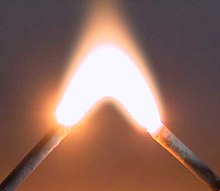Electric arc: Difference between revisions
| Line 17: | Line 17: | ||
Formation of an intense electric arc, similar to a small-scale [[arc flash]], is the foundation of [[exploding-bridgewire detonator]]s. |
Formation of an intense electric arc, similar to a small-scale [[arc flash]], is the foundation of [[exploding-bridgewire detonator]]s. |
||
Electric arcs have been studied for [[electric propulsion]] of spacecraft. |
Electric arcs have been studied for [[Electrically powered spacecraft propulsion|electric propulsion]] of spacecraft. |
||
==Undesired arcing==<!--section linked from Snubber--> |
==Undesired arcing==<!--section linked from Snubber--> |
||
Revision as of 15:53, 22 June 2010

An electric arc is an electrical breakdown of a gas which produces an ongoing plasma discharge, resulting from a current flowing through normally nonconductive media such as air. A synonym is arc discharge. The phenomenon was first described by Vasily V. Petrov, a Russian scientist who discovered it in 1802. An archaic term is voltaic arc as used in the phrase "voltaic arc lamp".
Overview


The various shapes of electric arc are emergent properties of nonlinear patterns of current and electric field. The arc occurs in the gas-filled space between two conductive electrodes (often made of carbon) and it results in a very high temperature, capable of melting or vaporizing most materials. An electric arc is a continuous discharge, while a similar electric spark discharge is momentary. An electric arc may occur either in Direct current circuits or in alternating current circuits. In the latter case, the arc may re-strike on each half cycle of the current. An electric arc differs from a glow discharge in that the current density is quite high, and the voltage drop within the arc is low; at the cathode the current density may be as high as one megaampere per square centimeter.[1]
An electric arc has a non-linear relationship between current and voltage. Once the arc is established (either by progression from a glow discharge [2] or by momentarily touching the electrodes then separating them), increased current results in a lower voltage between the arc terminals. This negative resistance effect requires that some positive form of impedance to be placed in the circuit, if it is desired to maintain a stable arc. This property is the reason uncontrolled electrical arcs in apparatus become so destructive, since once initiated an arc will draw more and more current from a fixed-voltage supply until the apparatus is destroyed.
Uses

Industrially, electric arcs are used for welding, plasma cutting, for electrical discharge machining, as an arc lamp in movie projectors and followspots in stage lighting. Electric arc furnaces are used to produce steel and other substances. Calcium carbide is made in this way as it requires a large amount of energy to promote an endothermic reaction (at temperatures of 2500 °C).
Low-pressure electric arcs are used for lighting, e.g., fluorescent tubes, mercury and sodium street lamps, and camera flash lamps.
Formation of an intense electric arc, similar to a small-scale arc flash, is the foundation of exploding-bridgewire detonators.
Electric arcs have been studied for electric propulsion of spacecraft.
Undesired arcing

Undesired or unintended electric arcing can have detrimental effects on electric power transmission, distribution systems and electronic equipment. Devices which may cause arcing include switches, circuit breakers, relay contacts, fuses and poor cable terminations. When an inductive circuit is switched off the current cannot instantaneously jump to zero; a transient arc will be formed across the separating contacts. Switching devices susceptible to arcing are normally designed to contain and extinguish an arc, and snubber circuits can supply a path for transient currents, preventing arcing. If a circuit has enough current and voltage to sustain an arc formed outside of a switching device, the arc can cause damage to equipment such as melting of conductors, destruction of insulation, and fire. An arc flash describes an explosive electrical event that presents a hazard to people and equipment.
Undesired arcing in electrical contactors can be suppressed by various devices, including:
- immersion in transformer oil, inert gas or vacuum
- arc chutes
- magnetic blowouts
Arcing can also occur when a low resistance channel (foreign object, conductive dust, moisture...) forms between places with different potential. The conductive channel then can facilitate formation of an electric arc. The ionized air has high electrical conductivity approaching that of metals, and can conduct extremely high currents, causing a short circuit and tripping protective devices (fuses, circuit breakers). Similar situation may occur when a lightbulb burns out and the fragments of the filament pull an electric arc between the leads inside the bulb, leading to overcurrent that trips the breakers.
Electric arc over the surface of plastics causes their degradation. A conductive carbon-rich track tends to form in the arc path, negatively influencing their insulation properties. The arc susceptibility is tested according to ASTM D495, by point electrodes and continuous and intermittent arcs; it is measured in seconds to form a track that is conductive under high-voltage low-current conditions. Some materials are less susceptible to degradation than others; e.g. polytetrafluoroethylene has arc resistance of about 200 seconds. From thermosetting plastics, alkyds and melamine resins are better than phenolic resins. Polyethylenes have arc resistance of about 150 seconds, polystyrenes and polyvinyl chlorides have relatively low resistance of about 70 seconds. Plastics can be formulated to emit gases with arc-extinguishing properties; these are known as arc-extinguishing plastics.
Arcing over some types of printed circuit boards, possibly due to cracks of the traces or the failure of a solder, renders the affected insulating layer conductive as the dielectric is combusted due to the high temperatures involved. This conductivity prolongs the arcing due to cascading failure of the surface.
See also
References
External links
- Unusual Arcing Photos
- Some more info about making electric arcs using a welder.
- Videos of 230 kV 3-phase "Jacobs Ladder" and unintentional 500 kV power arc
- High Voltage Arc Gap Calculator to calculate the length of an arc knowing the voltage or vice versa
- Electric Arc Calculator
